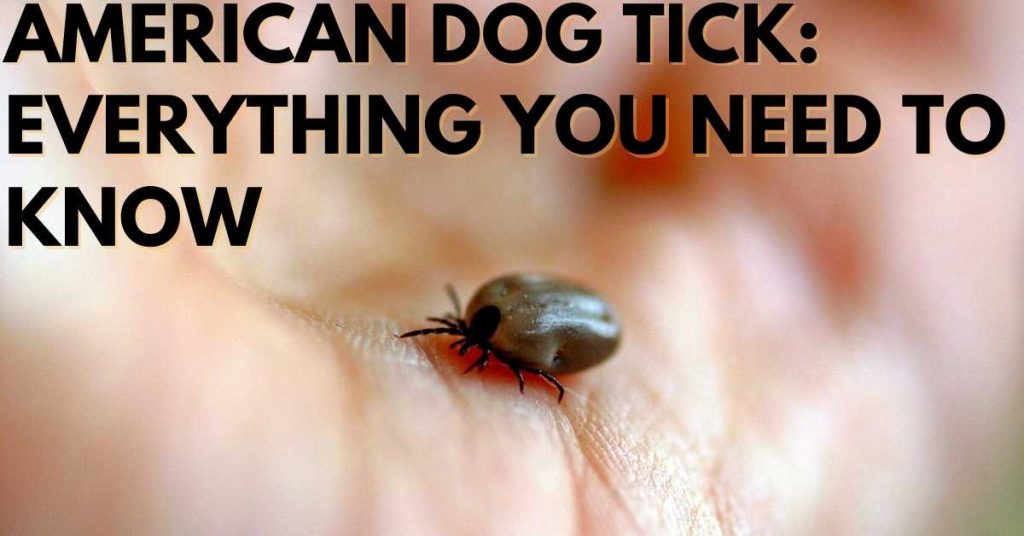
American Dog Tick, scientifically known as the Dermacentor variabilis, is abundantly found all over the United States. It is also known as Wood Tick. Dogs are the most preferred host of these ticks. The American Dog ticks require three different hosts during their life cycle. They are dangerous as they can spread various diseases such as Rocky Mountain spotted fever, babesiosis, etc. Learn more about the American Dog Tick, their distribution, their hosts, and how to prevent their bites.
What does the American Dog Tick look like?
The American Dog ticks are brown to reddish-brown. Females are 0.19 inches long, while males are 0.14 inches long. Females become larger after feeding. They grow up to 0.59 inches. Females possess a dorsal scutum on their back. While males have their shields covering the entire dorsal. Both have white/ gray color patterns on their backs.
Unfed larvae are yellow and measure 0.024 inches long. They have six legs. After feeding, the larva turns gray or black. Nymphs are buff in color. The fed ticks are slate grey. The white markings on the shield present in the adult ticks are absent in nymphs.
What Is The Geographical Distribution of the American Dog tick?
The American Dog Ticks are abundant in the Eastern, Upper midwest, Mid-Atlantic, and Central parts of the United States. Some prominent states include Nova Scotia, Michigan, Saskatchewan, California, Cascade, the Sierra Nevada, and Massachusetts.
How Do These Ticks Prey On Their Hosts?
Ticks have a behavior called questing. They wait on tips of grasses or bushes to climb on a host. They wait patiently for the host to brush against the place they are questing. During questing, the ticks stretch their forearms in the air to grab while their back limbs are attached to the grass or leaves.
American Dog Ticks use the odor of the animals. The odor comes from the animal, which follows trails. Some studies have confirmed that the American Dog tick quest even on the sides of the roads. It is important to note that Wood ticks, like any other ticks, do not fly or jump like any other ticks. They wait in areas where hosts are most likely to pass by.
When Can One Find American Dog Ticks?
American dog ticks can be a problem during spring and early summer. In May and June, nymphs and larvae are abundant. Adults are active in feeding during April and August. But you can encounter them at different times of the year according to the state they live in. So it is crucial to be safe throughout the year in tick abundant regions.
What Is The Duration Of The Wood Tick Bite?
The male tick bites for 1 to 2 days, whereas the Females feed for 7 days to more. Females get engorged after feeding, while males do not get swollen. Females and males feed before their reproductive roles. Males feed before mating and sperm production, while females feed to get nutrition for laying eggs. Female American Dog tick lays up to 6,000 eggs at a time.
What Are Their Preferable Hosts?
American Dog Ticks are three-host ticks. In their nymph and larvae stage, these ticks are host to small animals such as mice, rabbits, squirrels, skunks, cats, etc. The adult wood tick chooses large mammals to medium-size animals to feed on. After the adult stage, the tick feeds on large mammals, including dogs, humans, etc.
What Is The Life Cycle of the American Dog Tick?
The life cycle of the American dog tick has four phases – The egg, larvae, nymph, and adult. The American Dog Tick may take at least 54 days. But it may take the utmost two years to complete. These ticks are three host species that require blood meal from different hosts during each phase.
The duration of the completion of the life cycle depends on factors such as climatic conditions, temperature, and access to hosts.
Eggs:
After the completion of mating and blood meal, the female ticks drop off from the host. Females may feed for up to 5 days to 2 weeks. They would then lay eggs clutched in a suitable place. They may lay more than 6,000 eggs. These eggs hatch within 26 to 40 days. The time taken for hatching depends on the temperature of the region.
Larvae
Larvae come out of the eggs and search for hosts. They would quest for small animals. They may feed on from 2 days to 2 weeks. After completing their meal, it may take up to seven days to molt into a nymph. The larvae, without feeding, can last for 11 months.
Nymph:
The nymph without a meal can survive for half a year. They feed on medium-sized mammals such as possums. They would feed from 3 to ten days. The American Dog tick nymph takes many months to molt into an adult.
Adult:
After molting they look for a host. They can live for two years without feeding. The male and females mate while feeding. While feeding the males secrete an enzyme that helps in communicating their readiness to mate with other females. The half-fed females then mate with their male counterparts. They require large mammals such as horses , dogs, and humans as hosts Females die after eggs laying..
Do American Dog Ticks Carry Lyme Disease?
American Dog ticks, unlike Deer ticks, do not carry Lyme disease. But they may carry other harmful bacteria.
Are American Dog Ticks Dangerous To Humans?
American dog tick is the carrier of the causative agent Rickettsia rickettsii, the bacteria which causes the Rocky Mountain Spotted Fever. Rodents act as reservoir animals for the disease. This is then spread to humans or dogs through an infected tick bite. The adult can only cause the disease in humans as nymphs and larvae do not feed on humans. The larvae may also contract it through transovarial transmission from the females.
The symptoms of this disease are as follows:
- Fever
- Rash
- Head and muscle ache
- Nausea and vomiting
- Stomach ache
- Lack of Appetite
The RMSF Rash:
When febrile signs arise, the patients may encounter rashes. These rashes may look like pinpoint dots or appear like red splotches This is one of the typical signs of the RMSF but this occurs after days of fever.
Is this a chronic illness?
There are no chronic symptoms from RMSF, but this disease may result in damage to body parts. The RMSF affects the blood vessels that may damage organs such as legs, fingers, toes, or hands. This may result in paralysis.
Some common diseases that the American Dog Tick might spread
Tularemia:
- Pneumonia-Inflammation of the air sacs of the lungs.
- Meningitis Infection of the tissues around the brain
- Pericarditis – Inflammation of the sac-like tissue called pericardium located around the heart.
- Osteomyelitis Bone This is an infection of the bones.
Common symptoms include:
- Fever and chills
- Fatigue
- Swollen Lymph glands
- Chills
- Headache
- Ulcer on the tick bite area
Canine tick paralysis:
This occurs in dogs. If a dog cannot move either pair of legs, take it to the vet. As it may be a sign of the beginning stages of tick paralysis.
Prevention of American Dog Ticks:
American Dog ticks prevention is the best technique to inhibit the spread of the diseases they cause. The following tips can be helpful to prevent tick bites in the summer and in other climates from American dog ticks
- The use of acaricide for killing ticks in your backyard or garden could be helpful.
- Other natural options include growing tick-eating birds and animals: Chicken, opossums, wild turkey, etc.
- Cutting tall grasses.
- Using anti-tick medication in dogs
- Not venturing into tick-infested regions.
- Checking and removing ticks as and when one goes out.
- Limit skin exposure by wearing clothes that cover all the skin on the body.. Also, make sure to tuck your pants into your socks and your shirt in your pants.
How To Remove Ticks?
Tick removal requires the following equipment:
- PaperTowel
- Tweezers
- Latex Gloves
- Rubbing Alcohol with 70 to 90 percent isopropyl alcohol.
- Ziplock bag
Removal of tick:
- Use sharp tweezers to hold the tick close to the skin. Without wiggling with a steady hand, pull the tick out. Make sure not to break the tick.
- Look again for any residues or the head. Make Sure you remove it. Place all parts of the tick rubbing alcohol to kill it.
- Now place the dead tick in a ziplock bag. You may also flush it down the toilet if it is dead. If it is not dead and disposed of in the dustbin or toilet.
- If you are sending for tick analysis, safely send the tick in the Ziplock cover. Then rub the bite region, the gloves and the tweezers with rubbing alcohol.
Final Words:
If febrile illness signs arise make sure to check with your medical practitioner. This is significant as tick diseases can be dangerous. As tick populations are on the rise, make sure to protect yourself. Climatic change is on the effect, and you might see an increase in the population of ticks. So, it is better to take preventive methods to prevent yourself from tick bites.


